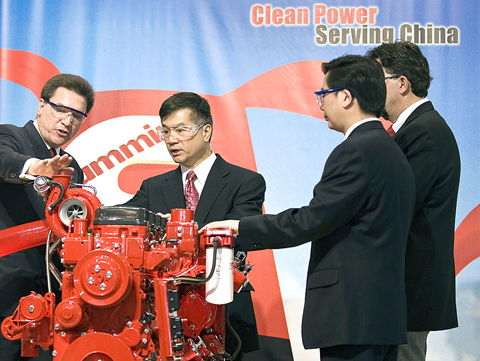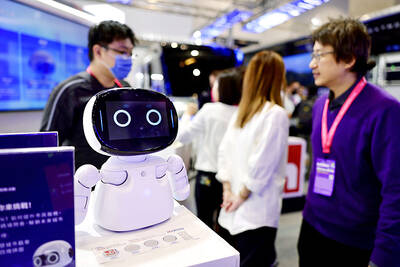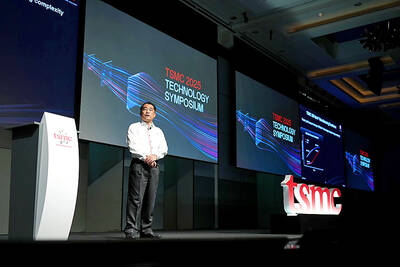The trade imbalance between the US and China is not sustainable and the two countries have a joint responsibility to reduce greenhouse gas emissions, US Commerce Secretary Gary Locke said yesterday.
China should shift from export-led growth, increase its exchange rate flexibility and open its markets more, Locke said in remarks prepared for a speech to the American Chamber of Commerce.
Locke, who will visit Beijing and Shanghai, plans to promote clean energy technology as one area in which US industry can find opportunities in China.

PHOTO: AP
“For all our areas of agreement, the US and China’s trade relationship has to evolve. There are concerns and deep structural issues that must be addressed,” Locke said.
“Chief among them is a bilateral trade imbalance that simply can’t be sustained. Growth predicated on ever increasing Chinese exports being consumed by debt-laden Americans provided years of prosperity — but it also sowed some of the seeds for our current economic problems,” he said.
The US is China’s second-largest trade partner after the EU and accounts for 18 percent of China’s total exports and imports.
“There do exist some issues in our bilateral trade relations, including cooperation on high-tech products,” Chinese commerce ministry spokesman Yao Jian (姚堅) told a press conference yesterday.
China’s big surplus in its trade with the US has become a global concern, he said.
“Of course, it’s a separate issue as how to interpret the trade surplus. In a globalized world today, trade surplus does not necessarily mean trade benefits,” Yao said, adding that China mainly exports labor-intensive products.
“China is trying to promote trade balance. We have special working groups that are in talks with the US side on promoting trade balance and cooperation on high-tech products,” he said.
US President Barack Obama will seek to restore balance in the two countries’ trade, Locke said, adding that the US trade deficit with China last year set a record near US$270 billion.
Locke praised China for taking steps to stimulate its domestic economy, but said it could help the world economy even more with further reforms.
“If China allowed for greater flexibility in its exchange rate and further opened up its domestic markets for imports and foreign direct investment, it would accelerate the world’s return to growth,” he said.
Locke is making his first trip to China as a member of the Obama administration.

DEMOGRAPHICS: Robotics is the most promising answer to looming labor woes, the long-term care system and national contingency response, an official said Taiwan is to launch a five-year plan to boost the robotics industry in a bid to address labor shortages stemming from a declining and aging population, the Executive Yuan said yesterday. The government approved the initiative, dubbed the Smart Robotics Industry Promotion Plan, via executive order, senior officials told a post-Cabinet meeting news conference in Taipei. Taiwan’s population decline would strain the economy and the nation’s ability to care for vulnerable and elderly people, said Peter Hong (洪樂文), who heads the National Science and Technology Council’s (NSTC) Department of Engineering and Technologies. Projections show that the proportion of Taiwanese 65 or older would

Nvidia Corp yesterday unveiled its new high-speed interconnect technology, NVLink Fusion, with Taiwanese application-specific IC (ASIC) designers Alchip Technologies Ltd (世芯) and MediaTek Inc (聯發科) among the first to adopt the technology to help build semi-custom artificial intelligence (AI) infrastructure for hyperscalers. Nvidia has opened its technology to outside users, as hyperscalers and cloud service providers are building their own cost-effective AI chips, or accelerators, used in AI servers by leveraging ASIC firms’ designing capabilities to reduce their dependence on Nvidia. Previously, NVLink technology was only available for Nvidia’s own AI platform. “NVLink Fusion opens Nvidia’s AI platform and rich ecosystem for

Taiwan Semiconductor Manufacturing Co (TSMC, 台積電) yesterday said it is building nine new advanced wafer manufacturing and packaging factories this year, accelerating its expansion amid strong demand for high-performance computing (HPC) and artificial intelligence (AI) applications. The chipmaker built on average five factories per year from 2021 to last year and three from 2017 to 2020, TSMC vice president of advanced technology and mask engineering T.S. Chang (張宗生) said at the company’s annual technology symposium in Hsinchu City. “We are quickening our pace even faster in 2025. We plan to build nine new factories, including eight wafer fabrication plants and one advanced

‘WORLD’S LOSS’: Taiwan’s exclusion robs the world of the benefits it could get from one of the foremost practitioners of disease prevention and public health, Minister Chiu said Taiwan should be allowed to join the World Health Assembly (WHA) as an irreplaceable contributor to global health and disease prevention efforts, Minister of Foreign Affairs Lin Chia-lung (林佳龍) said yesterday. He made the comment at a news conference in Taipei, hours before a Taiwanese delegation was to depart for Geneva, Switzerland, seeking to meet with foreign representatives for a bilateral meeting on the sidelines of the WHA, the WHO’s annual decisionmaking meeting, which would be held from Monday next week to May 27. As of yesterday, Taiwan had yet to receive an invitation. Taiwan has much to offer to the international community’s